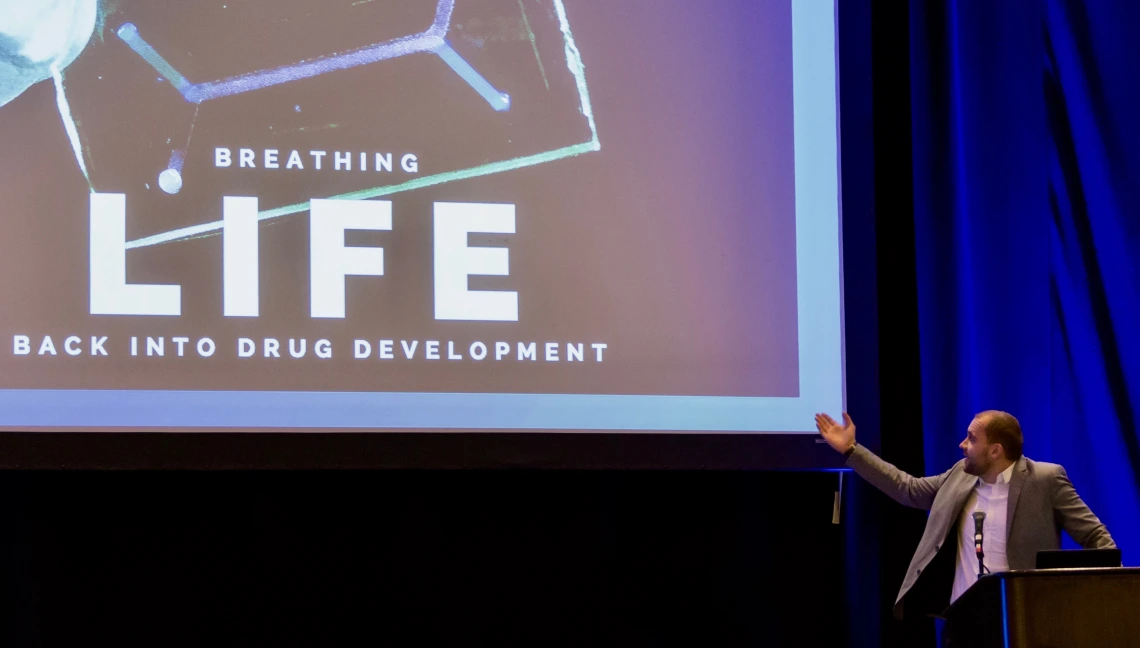UA Engineering Graduate Student Wins Big in Vegas at Thesis Competition
Biomedical engineer cashes in his “lung-on-a-chip” presentation.

Timothy Scott Frost gives his first-place presentation at the Western Association of Graduate Schools' 3-Minute Thesis competition in Las Vegas.
Timothy Frost stood before a group of graduate school deans, directors and representatives from across the western United States in a Las Vegas hotel. A timer with an enormous display was set for three minutes, and he began his presentation.
“Tonight on the strip, all the casinos combined earned a collective 18 million dollars,” he said. “That’s a lot of money for one night. But it would take all those casinos nearly six months of saving in order to foot the bill for a new treatment for heart disease or cancer.”
The audience was his. And, when all was said and done, so were the judges.
Frost, a doctoral student in the UA’s biomedical engineering program with a minor in aerospace engineering, tied for first place at the Western Association of Graduate Schools’ 3-Minute Thesis Competition for his presentation about “lung-on-a-chip” devices. He shared the first-place prize with Ian Foerster of the University of North Dakota.
Lungs on chips are small silicone devices that use real human cells to simulate the environment of a human lung. Using them to test new drug treatments is much cheaper and more accurate than existing methods such as animal testing. As Frost put it, your chances of coming out with an effective drug based on animal testing are about 10 percent -- the same odds as winning on the penny slots in downtown Vegas.
Frost represented the UA at the competition because he took first place at the 2017 UA-wide Grad Slam. While all of his presentations concerned his “lung-on-a-chip research, each was catered to a unique audience.
Tonight on the strip, all the casinos combined earned a collective 18 million dollars. That’s a lot of money for one night. But it would take all those casinos nearly six months of saving in order to foot the bill for a new treatment for heart disease or cancer.”
For example, in his UA presentation, he told the crowd that scientists using lung-on-a-chip technology could run 50 trials a day for the next 10 years for less than 2 percent of the cost of drug-testing methods used today. With the leftover money -- well over a billion dollars -- the UA could rebuild the BIO5 Institute ($66 million), rebuild Arizona Stadium ($75 million), build a new basketball arena ($120 million), pay for all of the research done on campus in the year 2016 ($606 million) and land on the moon in 2020 ($175 million). And there’d still be a little bit left over.
“Each time I’ve heard his presentation, I’ve been very impressed with his poise, his engagement with the research subject, and his ability to make such a compelling case to a nonspecialist audience about why his work is important,” said Meg Lota Brown, director of the UA Graduate Center.
When he presented at the Arizona 3-Minute Grad Slam, he adjusted his comparison: With the leftover money from using lung-on-a-chip trials, you could build Northern Arizona University’s Skydome ($31 million), the UA’s McKale Center ($124 million) and two Sun Devil football stadiums ($268 million), buy Surface Pros and MacBook Pros for every student at all three universities ($216 million and $288 million) and still send a man to the moon ($175 million).
Talk about hitting close to home.
Practice Makes Perfect
Frost has never taken a communications class, but he spends a lot of time working with young people. He volunteers with the Arizona Mathematics, Engineering, Science Achievement Outreach Program, with the UA’s KEYS Research Internship program for high school students and as a scoutmaster for a local boy scout troop.
“I think engineering students and engineers in general get a bad rap for having terrible communications skills, and that’s definitely valid. When I would teach my students, I would teach at a high level and just expect them to pick up what I’m saying,” he said. “Time and time again, I realized that doesn’t work. You really have to cater it to your audience.”
Frost estimates he’s gone through the presentation more than 400 times. To his wife, in the car on the way to school, while out on runs. Maybe the reason he he’s still nervous every single time is because his presentation is continually evolving. David Bradshaw, senior program coordinator of the UA Graduate Center, said that before Frost went to Vegas, he even incorporated some last-minute student feedback from a Grad Slam workshop to make his presentation slide presentation more accessible to people with colorblindness.
“He found a good balance between talking about the innovative science and the treatment testing applications of his work and the direct impacts it has on a nonspecialist audience,” Bradshaw said.
Frost said he is grateful the UA provided the opportunity to travel to WAGS, and that he’s learned a lot about being an effective engineer: Though it can be exciting to talk about how the work was done, he said, the most important thing is what work was done. He closed out his first-place presentation fittingly.
“It’s my hope that you can see that organ-on-a-chip devices are the jackpot that we’re hoping for in medicine today,” he said.

